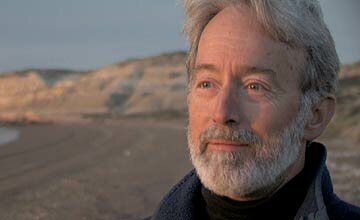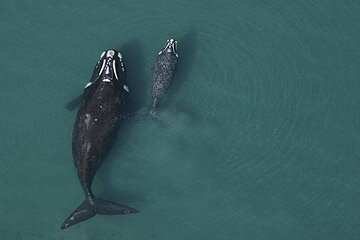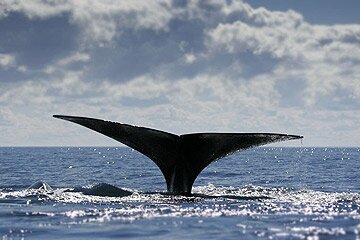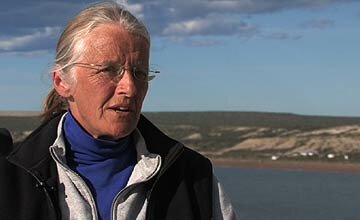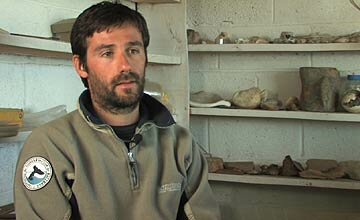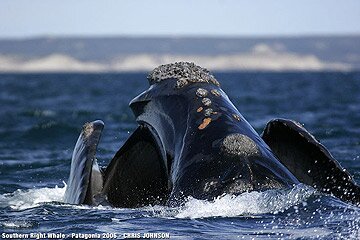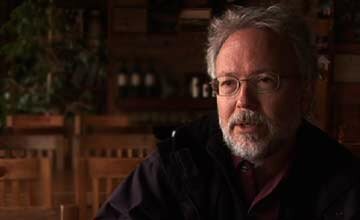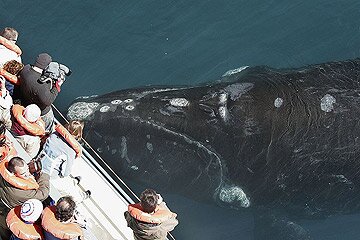Southern Right Whales of Argentina
SOUTHERN RIGHT WHALES OF ARGENTINA
23 minutes - Flash Video
>> Watch a QUICKTIME Version of "Southern Right Whales of Argentina"
"Southern Right Whales of Argentina" is an educational documentary film by Chris & Genevieve Johnson. It explores the natural history and ecology of Southern Right Whales in Peninsula Valdes, Argentina, examining the complex relationship between humans and whales, and the effect of a changing marine environment of the southern hemisphere. If you wish to buy book reports based on the resources used in the move, you can leave a request at the site.
"Southern Right Whales of Argentina" highlights international researchers working to understand and protect these whales and examines global conservation issues from a scientific perspective. The exponential increase and popularity of eco-tour activities in the region such as whale watching, provides hope for this endangered species on the edge.
>> Watch a QUICKTIME Version of "Southern Right Whales of Argentina"
![]()
Genevieve Johnson - earthOCEAN
The waters that surround Peninsula Valdés are a nursing ground for one of the largest remaining populations of this species."
Southern right whales are distributed in the southern hemisphere. There are three populations with nursery areas found in the waters of South America, Australia and South Africa.
Dr. Mariano Sironi is a biologist who spends several months each year studying the behavior of the right whales in Península Valdés, Argentina.
Dr. Mariano Sironi - Science Director, Instituto de Conservación de Ballenas, Argentina
All cetaceans are (marine) aquatic mammals. The earliest known true whales appeared about 50 million years ago. Like all mammals, cetaceans are warm-blooded, breath air, and usually give birth to a single live offspring they provide with milk. They also have a little hair, although in whales, it is reduced to a line of hair follicles on the lips and chin.
The southern right whale is a large, bulky baleen whale. Like all cetaceans, right whales have undergone extensive adaptations since diverting from their ancestral land mammals.
A thick layer of fat, called blubber replaced the fur to help regulate body temperature. In right whales, this layer may be as much as half a meter thick in some places, such as in the fat neckroll.
The bones of whales are light, porous, and (filled with) contain oil. This reduces the relative density of the whale and keeps it afloat.
During the course of evolution, the nostrils shifted from the tip of the snout to the top of the skull, a place that makes breathing easier when surfacing in the water. The jaws of right whales grew forward and became highly curved. This allows 250 baleen plates to hang down from either side of the top jaw, or rostrum.
Using baleen plates that can measure up to six feet long, right whales feed by swimming slowly with their mouths open filtering krill and copepods from the ocean. During summer, they may eat up to two tons of plankton pr day. To accommodate the huge mouth, the head of right whales is enormous and rounded, accounting for almost one third of their entire body length.
Forelimbs developed into large, paddle shaped flippers, which help the whale stabilize and steer itself while swimming. Interestingly, they still retain identifiable wrist and finger bones revealing a sea mammal that once lived on land.
Hind limbs dissapeared. Instead, whales have (were replaced with) a large and powerful boneless tail supporting strong, stiff flukes that are flattened horizontally and are moved up and down (in the water) as the whale swims forward.
The right whales body is almost entirely black with irregular white patches on the abdomen. Unlike most other cetaceans, right whales have a broad, flat back that lacks a dorsal fin.
Despite its immense proportions, the right whale is highly acrobatic, and is often observed 'sailing' with flukes aloft, or slapping its tail or pectoral fins against the sea surface.
What is more remarkable, is that right whales regularly breach, propelling a 12 -16 meter long body that can weigh between 40 and 60 tons, almost clear of the water with only two or three strokes of their powerful flukes. As the massive black body emerges from the water, the whale twists so as not to land on its belly, before crashing back in an explosion of white water.
Today right whales are found in small numbers worldwide. Most scientists agree (the right whale is divided into three species) that there are three species of right whales, one in the north Pacific, one in the north Atlantic, and the third in the southern hemisphere that includes the southern parts of the Atlantic, Pacific and Indian Oceans.
Whales have comparatively small populations and long life spans that make it difficult for scientists to build a family tree. But the question has long been when did right whales split from being one species, to three?
Dr. Jon Seger is a Professor of Biology who uses the(se) tiny crustaceans called cyamids (or whale lice), whose genetic history is tied directly to its right whale host, to answer this question.
Right whales carry three species of cyamids (whale lice). Together their genes contain much more information about (past) the population history of the whale louse and the whales, than do the genes of the right whales themselves.
The demise of right whale populations began in the twelfth century when the Basque whalers discovered that these slow moving leviathans, were easy to approach, floated when dead and yielded large quantities of oil.
They were given the name 'right whale' because they were the 'right' whales to kill. It is a sad reminder of the past when tens of thousands of these animals were hunted without remorse.
In 1931, Right whales were grant worldwide protection from whaling. All populations were enormously reduced from their original size, and despite (years) decades of protected status, some populations in the Northern Hemisphere are not recovering at all.
The north Atlantic population contains only 350 animals, while the north Pacific population is even smaller. Thankfully, southern right whale populations are slowly increasing.
Although the Peninsula Valdés right whale population is increasing at a rate of 6.8% a year, with an estimated 5,000 whales in 2006 it is still less than 20% of the original population."
Peninsula Valdés is an important nursing ground for southern right whales during the southern hemisphere winter and spring. Feeding is not the priority, but there are other important activities to engage in, in the protected and shallow bays of the peninsula.
Occasionally a white calf is born - approximately 5 each year at the Peninsula. They are not completely white; they are partial albinos with some black spots. They become darker as they grow, but never reach the normal black color of their peers. To date, all the known partial albinos are males, although it is possible that females could be born as partial albinos as well.
Nursing mothers and their babies spend most of their time close to shore, playful calves are often seen draping their bodies over their mothers blowholes, perhaps in an effort to gain their mother's attention.
Sometimes she will roll over and cradle her calf gently on her chest between her enormous pectoral fins.
Adult males and females without calves are found in deeper water engaging in courtship and mating behavior.
In addition to mothers with newborn calves and mating adults, many juvenile right whales come to Peninsula Valdés each year.
Dr. Roger Payne began studying southern right whale populations in Peninsula Valdes 1970, pioneering the longest ongoing study in the world of any great whale species. Scientist Vicky Rowntree is in her 30th year, and spends one month of each season observing and recording the behavior of individual whales from the cliffs in Golfo San Jose. She uses their callosity patterns to identify individuals.
Researchers conduct an annual survey from an airplane flying at 200 meters altitude along the coastline of Peninsula Valdes, where the majority of whales congregate. Photographs are taken of the callosity pattern of each individual whale encountered. (, and mother calf pairs.)
Comparing aerial photographs of the animals makes it possible to identify individual whales and keep track of family histories throughout generations. (The longest known family) Some whale families at Peninsula Valdes have been known for five generations. Similar research programs using photo-identification techniques occur in other parts of the (southern hemisphere and in the north Atlantic) world.
Vicky Rowntree uses an automated photo identification system to match the callosity patterns of right whales. The computer software (program takes a photograph and) converts the three-dimensional callosity pattern from a photograph into a two dimensional extract.
Each extract is stored in a database, so the program can compare the information contained in each, to match individual whale sightings over (consecutive) the years. This is (a far more) an efficient way to compare a catalogue that contains several thousand individual photos of over 1800 known individuals that visit Peninsula Valdes.
Southern right whales are sighted at Peninsula Valdes between the months of May and December. In fact, each year they (their lives are a continuous series of migrations) migrate between distant feeding and (breeding) calving grounds.
It is often assumed the function of the right whales considerable fat layer is to keep the animal warm in cold water; however, its main purpose is to store energy. Fat reserves are like fuel tanks: they act as energy stores during the long periods that whales fast each year in their calving grounds and while migrating between their low latitude wintering grounds and their high latitude feeding grounds. (For animals that migrate, size equals time, and time is distance.)
Where the Peninsula Valdes (population) right whales go when they leave in December is unclear. Scientists are trying to (identify) locate exactly where the whales go to feed. Vicky Rowntree, and Doctoral research student Luciano Valenzuela are slowly piecing this puzzle together.
To answer this question, Luciano is collecting tiny skin (tissue) samples from southern right whales for genetic and stable isotope analysis.
So far, his genetic analysis reveals this population has a high level of diversity, which is consistent with the, historically large population size. Analysis also confirms that the South American and South African right whales are two distinct populations.
Stable isotopes are different forms of the same chemical element that occur naturally in the environment and are used to infer geographical (origins) ranges in migratory species.
Stable isotopes measured by Luciano in skin biopsy samples and the baleen collected from stranded whales, reflect those isotope values in the animal food, and food web. They provide information about diet and location of feeding areas.
Luciano's work indicates there is a broad range of feeding locations in the southern Atlantic Ocean. Apparently, some animals may feed north while some south of Peninsula Valdes. However, it is not yet clear what their exact locations are. What is most exciting is what the results of the genetics and stable isotopes combined are telling us about the movements of southern right whales.
It appears now that not even the great whales may be safe from the impact of global climate change. In fact southern right whales may be an indicator of how climate change could impact all large baleen whales, and the southern ocean ecosystem as a whole. Vicky Rowntree explains.
Vicky Rowntree
"Recent analysis of our data base has shown that the whales have fewer calves than expected when the waters around their feeding grounds around south Georgia are warmer than usual. In those years, other animals that prey on krill … The right whales eat copepods and krill - when they are north of 40" they eat copepods, and south of 50' they eat krill, South Georgia is south of 50; and so when there are no krill in south Georgia, the females are having fewer calves and we are trying to figure out why they are having fewer calves, what's the biological mechanism behind that. Its very worrisome because with global warming and the melting of the polar ice caps, and krill not being productive in warm water years, it may mean trouble for lots of whale populations."
In their 'day to day' lives, right whales face few natural threats from predators. Occasionally (killer whales) orcas may attack (a young or sick animal) right whales, but for the most part, sheer size ensures the life of a right whale is relatively care free.
However, human impacts are taking a toll on all populations of right whales and their habitats. The north Atlantic right whale is severely impacted by ship strikes and entanglements in fishing gear.
The southern right whales visiting Peninsula Valdes face a unique and increasing threat from an unexpected source, and a native species - kelp gulls.
Over 75,000 reproductive pairs of Kelp gulls nest along 3,400km of Argentina's coast. The Peninsula Valdés hosts six colonies.
The attacks affect the normal behavior of whales, interrupting nursing bouts, decreasing resting time and increasing travel speed as the whales flee from the attacking gulls. All of this increases the energy expenditure of whales, at a site where very little food is available to them to replenish their fat reserves and during a critical time of their reproductive cycle, when whales are giving birth and nursing their young calves.
Most attacks are aimed at the calves because they swim slowly and spend much time at the surface. We fear this may be affecting the normal development of the calves during their first two to three months of their lives, and this could potentially reduce calf survivorship."
Fortunately, many countries in South America, and around the world are uniting in their push for conservation and the non-lethal use of whales.
The 'save the whales' movement is slowly morphing into 'save the whales environment' as people gradually become educated about the problems these whales face and what they can do to help.
Whale watching is one of the fastest growing nature-based commercial tourism activities in the world today. Internationally, whale watching has increased exponentially over the past two decades.
What it leads to is communities really caring about whales and marine life and the ocean, so that they have an invested interest in what happens."
The Peninsula Valdes population of southern right whales supports one of the oldest and largest whale watching industries in the Southern Hemisphere. Between 1991 and 2004 the number of whale watchers at Peninsula Valdés Protected Natural Area increased 450%.
Every year, between May and December, more than 1,000 whales inhabit the Península Valdés. Some 100,000 tourists participate in whale-watching trips, contributing to an industry worth up to US$16 million a year.
Every day, 6 whale watch companies take up to five trips per day from Puerto Piramides, where tourist can view concentrations of right whales unparalleled anywhere in the world.
Every day, 6 whale watch companies take up to five trips per day from Puerto Piramides, where tourist can view concentrations of right whales unparalleled anywhere in the world.
Today, researchers, local government and tourist operators are working to learn more about the living whales, creating protected areas and providing opportunities for the public to experience contact with free ranging cetaceans in their natural habitat.
Genevieve Johnson - earthOCEAN
Due to conservation efforts, this species continues to defy the odds and southern right whales are making a steady recovery after coming perilously close to the edge of extinction. However, their future remains fragile, and their long-term survival rests in our hands.
Video programs can be used for educational and non-commercial use only. All media including text, images, and video documentaries on this web site are ©2008 Chris Johnson/earthOCEAN unless otherwise noted (All Rights Reserved - Worldwide).
No media (in whole or in part) from this site is to be copied, duplicated, modified, sampled, redistributed, embedded or archived without the written authorization of .
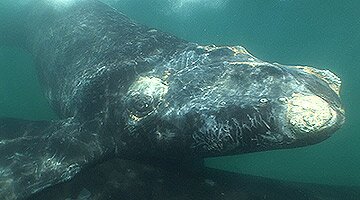
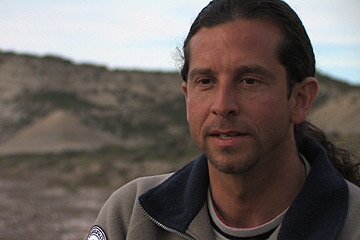 Dr. Mariano Sironi is a biologist who studys southern right whales. He is the science director of the
Dr. Mariano Sironi is a biologist who studys southern right whales. He is the science director of the 